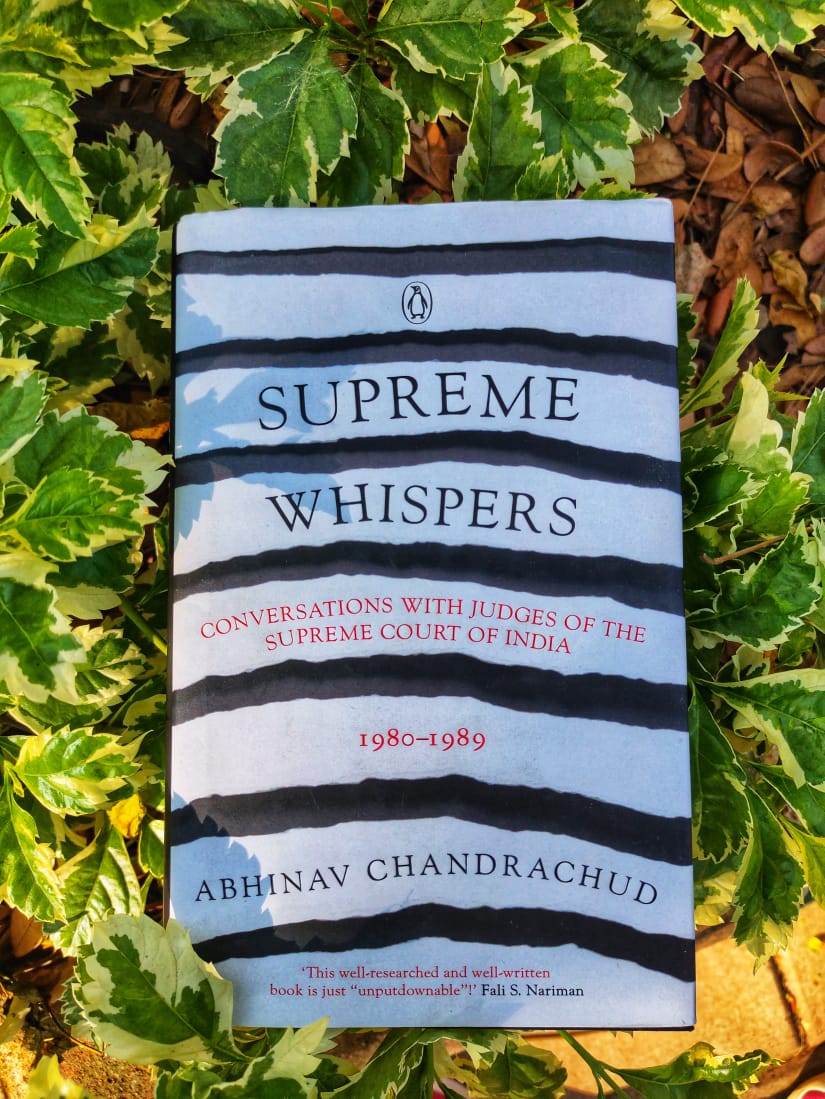We are introducing our book review section with the review of “Supreme Whispers”, which is authored by “Abhinav Chndrachud”. This introductory column is written by “Shriraja. S.”, a student of BBA LLB.
The idea of having the privilege of being neutral and unprejudiced is a misconception. When you place the utmost reliance on the expositor of law sitting on the highest court of this country, you hope for justice to be indeed served without prejudice. But, there is no perfect man, for he would otherwise be called God. Supreme Whispers written by Abhinav Chandrachud is a compelling non-fiction novel which exceptionally accentuates the mysterious closed doors of the Supreme Court of India during the 1980s. A peek into the lives of the then Supreme Court judges whose varied belief systems have impacted judicial interpretation. The author draws together strings of influences and patterns identified from a series of interviews conducted by a scholar Prof. George H. Gadbois Jr., with various judges of the Supreme Court of India, politicians, adept senior lawyers and family members during 1980 – 1989.
The book is integrated under six heads highlighting the prominent aspects of the judicial tenure of a Supreme Court judge thus revealing astonishing facts of the judicial mindset prevailing at that time. Under the first chapter titled ‘Judicial Rivalries’, the reader is exposed to acute conflicts between the judges who combat struggles with respect to political ideals, professional resentments, personal opinions with one another especially pointing out the tussle between the chief justice and the most senior judge of the Supreme Court.
As the book progresses further, under the second chapter titled ‘Disagreement without Dissent’, the author brings out the contrasting nature of the previously identified personal battles of the judges between each other which does not vocalize on paper. Meaning, despite judges having varied differences amongst themselves, despite there being disagreement on judicial interpretation, ultimately, the court presents a united front without dissenting opinions. There is a hint of suppression of voice of the arbiter of law at times by restraint exercised due to technical aspects of seniority.
Under the third chapter titled ‘Special Leave, a Special Burden’, one of the reasons for lack of dissent amongst the judges is determined. The popular concept of Special Leave Petitions and the burden that it imposes upon judges leaving them with less or no time to propagate a dissenting opinion is explained. When a significant portion of a judge’s productive time is invested in hearing the sometimes superfluous special leave petitions, a judge fails to devote his thought towards expressing dissent when needed simply because it is an additional task for a judge to echo a dissenting judgment. The chapter highlights the liberal disparity brought out by the Supreme Court judges of Independent India as compared to the previous stringent method adopted by the Privy Council in hearing special leave applications leaving needless load on the judges.
In the fourth chapter titled ‘Decliners’, an interesting arena of judicial appointments is described. This chapter deals with those who refused the colourable prestigious offer of elevation to the Supreme Court. Many lawyers have turned down the attractive judgeship providing various reasons, mostly highlighting the poor view held by most people in the legal fraternity about the judicial position. As much as one would deem it an honour to be promoted to the Supreme Court as a judge, the position is displayed as a mask revealing poor economic status of the judges owing to the salaries and lack of opportunity of independent thinking.
Under the fifth chapter titled ‘The Fictional Concurrence of the Chief Justice’, the ever expanding executive influence on judicial pronouncements and appointments is exposed.What should be an area where the Chief Justice be provided an opportunity to appoint judges to the court depending upon legal calibre, enormous interference by the Executive with hidden political agenda leads to undermining the independence of judiciary. A view into the despicable tactics of transfers, supersessions and non confirmation of appointments used by the Executive to terrorize the Chief Justice and other judges into accepting appointments goes to highlight that an independent judiciary is a myth. The chapter further explains the weapons brought out by the judiciary in tackling executive influence in the form of the collegium system.
In the final chapter titled ‘Criteria for Selecting Judges’, various unspoken guidelines are adopted by the judges as well as the executive government in appointing judges to the Supreme Court in an effort to strike a flawless balance, some reasons being worthwhile while some being unwarranted. A plethora of factors such as regional backgrounds, minority status, political ideals and leanings, integrity, personal habits etc., are seen in active play while making judicial appointments. Ofcourse, the merit of a judge is considered too.
This book attempts to present before its readers the never ending prejudices and rationales that are portrayed yet skilfully masked by the Supreme Court. All is not well under the hood. Despite this being an account from the 1980s, most phenomena derived from these interviews continue to be true, relevant and in existence even to this day. The book encourages the reader to hold a neutral view and regard towards the ‘supreme’ judiciary while in fact showing that no one is free from bias. What one can learn is that the ‘judicial mindset’ is simply a reflection of ‘ordinary human thought’. A highly gripping book recommended for the reader to probe questions against the enormous esteem and admiration placed upon the judiciary.
Where to read this book?
This book is available at amazon.in. check the link given below-
